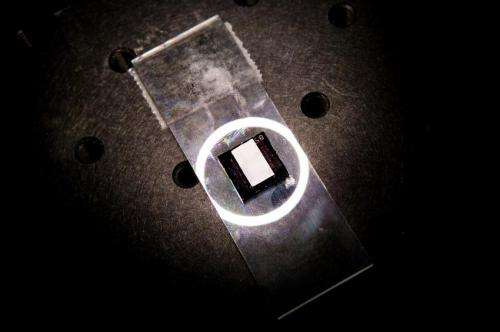Team developing wearable tech for disease monitoring

A new wearable vapor sensor being developed at the University of Michigan could one day offer continuous disease monitoring for patients with diabetes, high blood pressure, anemia or lung disease.
Wearable technologies, which include Google Glass and the Apple iWatch, are part of a booming market that's expected to swell to $14 billion in the next four years.
The new sensor, which can detect airborne chemicals either exhaled or released through the skin, would likely be the first wearable to pick up a broad array of chemical, rather than physical, attributes. U-M researchers are working with the National Science Foundation's Innovation Corps program to move the device from the lab to the marketplace.
"Each of these diseases has its own biomarkers that the device would be able to sense," said Sherman Fan, a professor of biomedical engineering. "For diabetes, acetone is a marker, for example."
Other chemicals it could detect include nitric oxide and oxygen, abnormal levels of which can point to conditions such as high blood pressure, anemia or lung disease.
Fan is developing the sensor with Zhaohui Zhong, an associate professor of electrical and computer engineering, and Girish Kulkarni, a doctoral candidate in electrical engineering. The researchers say their device is faster, smaller and more reliable than its counterparts, which today are much too big to be wearable. The new sensor can also detect a broader array of chemicals.
Beyond disease monitoring, the sensor has other applications. It would be able to register the presence of hazardous chemical leaks in a lab, or elsewhere, or provide data about air quality.
"With our platform technology, we can measure a variety of chemicals at the same time, or modify the device to target specific chemicals. There are limitless possibilities," Zhong said.
To create their technology, the researchers took a unique approach to detecting molecules.
"Nanoelectronic sensors typically depend on detecting charge transfer between the sensor and a molecule in air or in solution," Kulkarni said.
However, these previous techniques typically led to strong bonds between the molecules being detected and the sensor itself. That binding leads to slow detection rates.
"Instead of detecting molecular charge, we use a technique called heterodyne mixing, in which we look at the interaction between the dipoles associated with these molecules and the nanosensor at high frequencies," Girish said.
This technique, made possible through the use of graphene, results in extremely fast response times of tenths of a second, as opposed to the tens or hundreds of seconds typical in existing technology. It also dramatically increases the device's sensitivity. The sensor can detect molecules in sample sizes at a ratio of several parts per billion.
These nanoelectronic graphene vapor sensors can be completely embedded in a microgas chromatography system, which is the gold standard for vapor analysis, the researchers say. The entire microgas chromatography system can be integrated on a single chip with low power operation, and embedded in a badge-sized device that can be worn on the body to provide noninvasive and continuous monitoring of specific health conditions.
"We believe this device can be extremely beneficial to society," Fan said.
More information: The technology is described in the paper, "Graphene nanoelectronic heterodyne sensor for rapid and sensitive vapour detection," which is published in Nature Communications.
Journal information: Nature Communications
Provided by University of Michigan



















